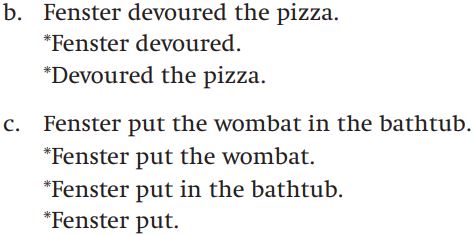
Argument structure and morphology
 المؤلف:
Rochelle Lieber
المؤلف:
Rochelle Lieber
 المصدر:
Introducing Morphology
المصدر:
Introducing Morphology
 الجزء والصفحة:
144-8
الجزء والصفحة:
144-8
 24-1-2022
24-1-2022
 1688
1688
Argument structure and morphology
Above, we defined the valency of a verb as the number of arguments it takes. Arguments, in turn, are defined as those phrases that are semantically necessary for a verb or are implied by the meaning of the verb. Generally, arguments occur obligatorily with a verb, as the examples in (1) show:


The verb snore has only one argument, its subject noun phrase. Verbs that have only one argument are traditionally called intransitive. The verb devour requires two arguments, its subject and object noun phrases. Two argument verbs are transitive. And the verb put requires a subject, an object, and another phrase that expresses location. If a verb requires three arguments, it is traditionally called ditransitive.
The arguments of a verb are often, but not always, obligatory. For example, the verb eat must have a subject, and it can have an object, but the object is not necessary.

Although it is optional we still consider the object tin cans to be an argument of the verb because the verb eat implies something eaten, even if that something is not overtly stated; notice that in (2b), we assume that the goat eats something (more specifically, we assume that the goat eats something foodlike, if we don’t explicitly say otherwise, as we do in (2a).
Of course, in English it is always possible to add prepositional phrases to a sentence that express the time or location of an action, the instrument with which it is done, or the manner in which it is done (Fenster put the wombat in the bathtub with great care on Thursday . . .). These extra phrases are not necessary to the meaning of the verb, however, and are not arguments. Instead, they are called adjuncts. We will not need to talk about adjuncts here.
Valency-changing morphology alters the number of arguments that occur with a verb, either adding or subtracting an argument, making an intransitive verb transitive or a transitive verb intransitive, for example. English has some morphology that changes argument structure, but other languages, as we will see, have far more morphology of this sort.
 الاكثر قراءة في Morphology
الاكثر قراءة في Morphology
 اخر الاخبار
اخر الاخبار
اخبار العتبة العباسية المقدسة


